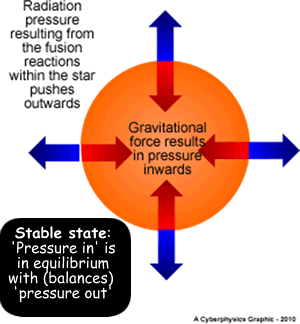 to find out about Star Birth to find out about Star Birth
 to find out about Star Death to find out about Star Death
The Main Sequence
When the core of the protostar becomes hot enough and there is sufficient pressure on the atoms inside the process of nuclear fusion begins.
Formation of elements other than hydrogen and helium
During this period of a stars life the fusion of nuclei within the star occurs forming elements with atomic numbers up to 26 (iron). (Elements heavier than iron are formed in a supernova).
Energy output from a star
The fusion reaction is what makes stars shine.
There is a lot of energy released when fusion occurs and this is sent out into the Universe in the form of electromagnetic radiation.
We can only see the visible light emitted from stars and only feel the infra red emitted from our star - the Sun - but electromagnetic radiation from the full spectrum is emitted from a star in its main phase.
We can observe this radiation using telescopes that detect the part of the electomagnetic spectrum that the telescope is made to detect. This information is then translated into visible images by a computer so that we can have a visual representation of what the star is emitting in that region of the spectrum.

So during most of the lifetime of a star, the interior heat and radiation is provided by nuclear reactions near the center; this is phase of the star's life is called the main sequence and is the stable phase of the star.
Forces within the star
 The force of gravity is continually trying to cause the star to collapse but this is counteracted by the pressure of hot gas and/or radiation in the star's interior. The two processes create a dynamic equilibrium. This is called hydrostatic support and results from the pressure inwards being balanced by the pressure outward. Our Sun is almost halfway through its 10 billion year stable phase.For more detail on this look at this NASA page The force of gravity is continually trying to cause the star to collapse but this is counteracted by the pressure of hot gas and/or radiation in the star's interior. The two processes create a dynamic equilibrium. This is called hydrostatic support and results from the pressure inwards being balanced by the pressure outward. Our Sun is almost halfway through its 10 billion year stable phase.For more detail on this look at this NASA page
|


